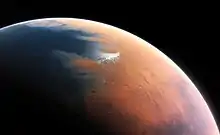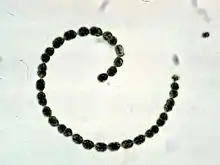Astro microbiology
Astro microbiology, or exo microbiology, is the study of microorganisms in outer space. It stems from an interdisciplinary approach, which incorporates both microbiology and astrobiology. Astrobiology's efforts are aimed at understanding the origins of life and the search for life other than on Earth. Because microorganisms are the most widespread form of life on Earth, and are capable of colonising almost any environment, scientists usually focus on microbial life in the field of astrobiology. Moreover, small and simple cells usually evolve first on a planet rather than larger, multicellular organisms, and have an increased likelihood of being transported from one planet to another via the panspermia theory.[1]
Planetary Exploration

The search for extraterrestrial microbial life have focused mostly on Mars due to its promising environment and close proximity; however, other astrobiological sites include the moons Europa, Titan and Enceladus. All of these sites currently have or have had a recent history of possessing liquid water, which scientists hypothesize as the most consequential precursor for biological life. Europa and Enceladus appear to have large amounts of liquid water hidden beneath the layers of ice that covers their surfaces. Titan, on the other hand, is only planetary body besides Earth with liquid hydrocarbons on its surface. Mars is the main area of interest for the search for life primarily because of convincing evidence that suggests surface liquid water activity in recent history. Furthermore, Mars has an atmosphere containing abundant amounts of carbon and nitrogen, both essential elements needed for life.[2]
Discoveries
So far, the search for microbial life in extraterrestrial locations have been less than successful. The first of such attempts, occurred through NASA's Viking program in the 1970s, in which two Mars landers were used to conduct experiments that searched for biosignatures of life on Mars. The landers utilized robotic arms to collect soil samples into sealed containers that were brought back to Earth. The results were largely inconclusive, although some scientists still dispute them.
In 2008, Russian cosmonauts reported findings of sea plankton living on the outside surfaces of the International Space stations windows. They have yet to find explanations for the discovery, but it seems to have been a result of human contamination, though this may never be proven.
Currently, the Mars Science Laboratory mission has a rover on Mars that continues to be operational. Launched on 26 November 2011, and landing at Gale Crater on 6 August 2012, its goals are to assess the habitability of Mars' environment – amongst its collection of data for Martian geology, climate and availability of water, are instruments that search for biosignatures daily. Thus far, its results have not been fruitful.
Future Missions
| Mission Title | Launch Date | Agency | Objectives |
|---|---|---|---|
| Mars 2020 | 2020 | NASA | Mobile rover unit that will scavenge Mars' surfaces and collect soil samples [3] |
| Europa Clipper | 2023 | NASA | Satellite launch that will orbit Jupiter's moon Europa and perform detailed reconnaissance of environmental conditions as well as search for potential landing sites [3] |
Experimentation
Earth
Many studies on Earth have been conducted to collect data on the response of terrestrial microbes to various simulated environmental conditions of outer space. The responses of microbes, such as viruses, bacterial cells, bacterial and fungal spores, and lichens, to isolated factors of outer space (microgravity, galactic cosmic radiation, solar UV radiation, and space vacuum) were determined in space and laboratory simulation experiments. In general, microorganisms tended to thrive in the simulated space flight environment – subjects showed symptoms of enhanced growth[4] and an uncharacteristic ability to proliferate despite the presence of normally suppressive levels of antibiotics. In fact, in one study, trace (background levels) of antibiotic exposure resulted in acquisition of antibiotic resistance under simulated microgravity.[5] The mechanisms responsible for explaining these enhanced responses have yet to be discovered.[6]
Space
The ability of microorganisms to survive in an outer space environment was investigated to approximate upper boundaries of the biosphere and to determine the accuracy of the interplanetary transport theory for microorganisms. Among the investigated variables, solar UV radiation had the most harmful effect on microbial samples. Among all the samples, only lichens (Rhizocarpon geographicum and Xanthoria elegans) fully survived the 2 weeks of exposure to outer space. Earth's ozone layer greatly protects against the deleterious effects of solar UV, which is why organisms typically are unable to survive without ozone protection. When shielded against solar UV, various samples were able to survive for long periods of times; spores of B. subtilis, for example, were able to proliferate in space for up to 6 years. The data support the likelihood of interplanetary transfer of microorganisms within meteorites, called lithopanspermia hypothesis.[6]
Mars

Modern technology has already allowed us to use microbes to assist us in extracting materials on Earth, including over 25% of the our current copper supply. Similarly, microbes could help serve a similar purpose on other planets to mine resources, extract useful materials, or create self-sustaining reactors. The most promising of these candidates known to date is cyanobacteria. Billions of years ago, cyanobacteria originally helped us create a habitable Earth by pumping oxygen into the atmosphere, and manage to exist in the darkest corners of the Earth. Cyanobacteria, along with some other rock-eating microbes, seem to be able to withstand the harsh conditions of the vacuum of space without much effort. On Mars, however, cyanobacteria will not even have to endure such harsh conditions.[7]
Scientists are currently working on the possibility of installing bioreactors or similar facilities on Mars, which would run entirely on cyanobacteria and provide material for the creation of fuel cells, soil crust formation, regolith amelioration, extraction of useful metals/elements, nutrient release into the soil, and dust removal; a variety of other potentially useful functions are also in the works.[7]

References
- Rahamathulla, Mohamudha. "Exo microbiology (or Astro microbiology)". Prince Sattam bin Abdulaziz University. Retrieved 12 May 2016.
- Davila, Alfonso (10 September 2010). "Astromicrobiology". Encyclopedia of Life Sciences (PDF). doi:10.1002/9780470015902.a0021899. ISBN 978-0470016176 http://onlinelibrary.wiley.com/store/10.1002/9780470015902.a0021899/asset/a0021899.pdf?v=1&t=io3v5qmq&s=0b2b4f2b1c2ad43d928103c34c0febbf39660bdc&systemMessage=Wiley+Online+Library+will+be+unavailable+on+Saturday+14th+May+11%3A00-14%3A00+BST+%2F+06%3A00-09%3A00+EDT+%2F+18%3A00-21%3A00+SGT+for+essential+maintenance.Apologies+for+the+inconvenience. Retrieved 12 May 2016. Missing or empty
|title=(help) - Cohen, Mark (2003). "Global Overview: Returned Astrobiology Sample Mission Architectures". SAE International. 2675.
- Tirumalai MR, Karouia F, Tran Q, Stepanov VG, Bruce RJ, Ott M, Pierson DL, Fox GE (May 2017). "The adaptation of Escherichia coli cells grown in simulated microgravity for an extended period is both phenotypic and genomic". NPJ Microgravity. 3 (15): 15. doi:10.1038/s41526-017-0020-1. PMC 5460176. PMID 28649637.
- Tirumalai MR, Karouia F, Tran Q, Stepanov VG, Bruce RJ, Ott M, Pierson DL, Fox GE (January 2019). "Evaluation of acquired antibiotic resistance in Escherichia coli exposed to long-term low-shear modeled microgravity and background antibiotic exposure". mBio. 10 (e02637-18). doi:10.1128/mBio.02637-18. PMC 6336426. PMID 30647159.
- Horneck, Gerda (2010). "Space Microbiology". Microbiology and Molecular Biology Reviews. 74 (1): 121–156. Bibcode:2010MMBR...74..121H. doi:10.1128/mmbr.00016-09. PMC 2832349. PMID 20197502.
- Hsu, Jeremy (9 September 2010). "How Microbes Could Help Colonize Mars". Astrobiology Magazine. NASA. Retrieved 12 May 2016.